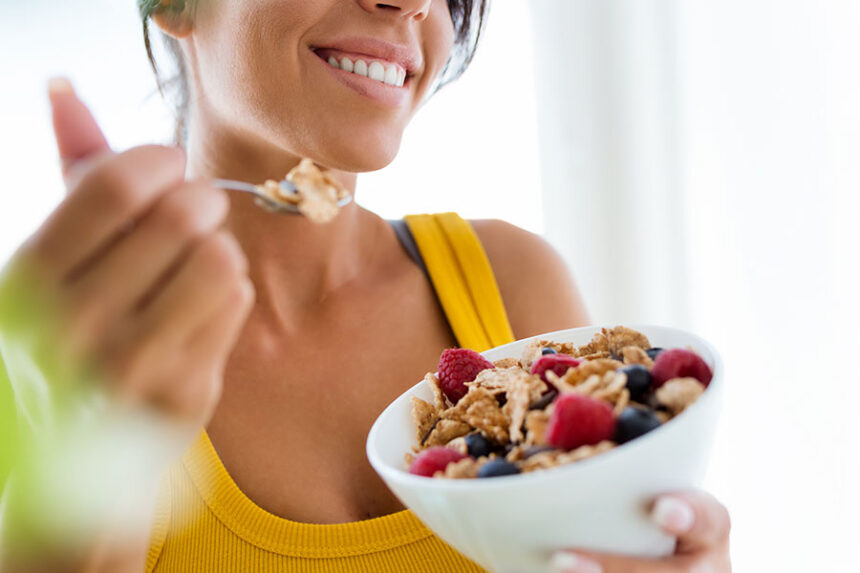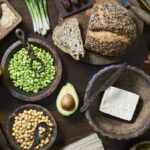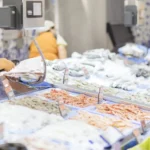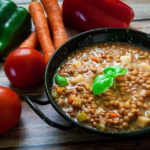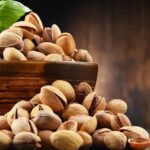What is the menstrual cycle?
The menstrual cycle is a physiological mechanism in which our body prepares for reproduction.
Throughout the cycle there are a series of hormonal changes and fluctuations that have a great impact on a woman’s reproductive system and her overall health.
Menstruation is a vital sign, a diagnostic tool like swelling, fever or decomposition and unlike menstruation these seem to be much more normalized in society.
The absence of the period is an alarm signal that tells us that something is not working properly and we must pay attention. Ovulation is not only useful to reproduce and get pregnant, it is essential for many other things and to avoid possible problems in the future (osteoporosis, cardiovascular diseases, cancer, etc.).
How long does the menstrual cycle last and what does it consist of?
Our environment can condition us to choose some foods or others depending on the phase of the cycle in which we find ourselves.
If you like, I will quickly explain what a healthy woman’s cycle consists of so that it is well understood.
In a 28-day menstrual cycle (to make it more rounded) we can differentiate two phases of 14 days each (from day 1 to 14 would be the follicular phase and from 15 to 28 the luteal phase, and in between these two we find ovulation.
Follicular phase
The first day of the cycle (follicular phase) is the day of menstruation and lasts between 3 and 7 days approximately.
In this first phase, FSH (follicle stimulating hormone) and estrogen levels will increase in the ovary.
This is when the follicle begins to develop thanks to the thickening of the endometrium and FSH until it reaches full maturation. This is when estrogens are at their highest and give way to another hormone, LH (luteinizing hormone), which is responsible for the rupture of the follicle and ovulation (approximately day 14-16).
Luteal Phase
In the luteal phase, the follicle becomes an endocrine hormone-releasing structure called the corpus luteum. This body begins to produce progesterone, which is responsible for maturing the endometrium so that implantation (pregnancy) can take place. If it does not occur, progesterone and estrogens drop drastically and endometrial detachment occurs, leading to menstruation and a new start of the cycle.
Is my menstrual cycle healthy?
Remember that every woman is different and each one of us has her own menstrual cycle. Moreover, the same woman can have different menstrual cycles.
Even so, here are the signs that determine whether a menstrual cycle is healthy or not.
- Absence of pain: Menstrual pain in women is very normalized and it should not be so. Discomfort is not the same as pain. Menstruation does not have to hurt. If so, I advise you to go to your gynecologist and describe your signs and symptoms (essential to rule out endometriosis).
- Cycle length. It depends on each woman. As a general rule it is usually between 24 and 30 days, but it can also last between 21 and 35 days. Each woman has her own cycle, what may be normal for one may be pathological for another.
- Amount of blood: 60-80ml. Very abundant and long-lasting bleeding may be a sign of hyperestrogenism (endometriosis, presence of fibroids, clots, etc.).
- Duration of bleeding: Menstruation usually lasts between 3-5 and 7 days, it should not last more than 7.
- There should be no Pre-Menstrual Syndrome (PMS). It is a concept that is too normalized. It is an indicator that our cycle is not healthy, only a few women suffer from it. Remember that PMS are those emotional and physical disturbances that make your day to day life impossible, not the changes in the cycle. These symptoms are usually both physical and psychological, including insomnia, sadness, depression, irritability, etc.
Does diet influence the menstrual cycle?
The answer is yes. The hormonal impact that an energy or nutrient deficiency can cause is very significant, since it can alter the functioning of our hormones (FSH, LH, estrogens, progesterone), suspend ovulation and finally menstruation. Without ovulation there is no menstruation. This is a concept that I will repeat many times throughout this post as it is one of the concepts that I want to make very clear.
Energy deficiency
It is very important to understand that ovulation is a process that requires a lot of energy to take place. If we add to the energy expenditure an energy restriction (hypocaloric, restrictive, nutrient deficient diets) the menstrual cycle can be lost as in the case of many women with hypothalamic amenorrhea. This is called suppression of the gonadal axis.
Think that if the body does not have enough energy, it will act as a survival mode and will use that energy for the functioning of other vital organs such as the brain or the heart in order to keep us alive. The menstrual cycle will remain in a second place, totally aside. Losing menstruation is a manifestation of the body that tells us that something is wrong.
Diet is not the only factor that influences the menstrual cycle, but also other factors such as lack of rest, psychological stress, physiological stress (excessive sport), the environment, toxins, etc.
Insufficient consumption of healthy fats
As a general rule in consultation, women tend to under-consume protein and healthy fats in relation to the recommended daily intakes.
Fats are super important throughout the menstrual cycle because cholesterol is the precursor of sex hormones (remember that estrogen and progesterone are formed from cholesterol). If there is not an adequate intake of healthy fats the sex hormones will not be produced or will not function properly.
Nutrition in the different phases of the cycle
Our hormonal environment can condition us to choose some foods or others depending on the phase of the cycle in which we find ourselves.
Menstruation
The first half of the cycle begins with the first day of menstruation. Progesterone is a thermoregulatory hormone and during this phase its levels drop dramatically as well as our body temperature. During this stage we feel much more lethargic and in discomfort due to this bleeding. One of the main nutrients I like to keep in mind during this phase is iron. This mineral is lost in large quantities during menstruation along with water. Therefore, hydration takes on a special role.
Iron can be found in both animal foods (meat, fish, seafood) and vegetable foods (legumes). Vegetable iron (non-heme iron) is less bioavailable, so taking it with foods rich in vitamin C (citrus fruits, tomatoes, peppers) and A (reddish-orange vegetables) would increase its absorption. It is also necessary to take into account foods that inhibit its absorption (dairy products, coffee, tea or cocoa).
Understanding that menstruation is a physiological inflammation, providing foods rich in omega 3 and the use of anti-inflammatory spices can play in our favor. Omega 3 is found in oily fish, nuts and some seeds such as flax, chia or hemp.
Follicular phase
Once menstruation is over, we enter the second part of the follicular phase. In this phase we find ourselves with much more energy. On a hormonal level there is an increase in insulin sensitivity due to increased estrogen levels. This is when the follicle begins to develop thanks to the thickening of the endometrium and FSH until it reaches maturity. Minerals such as zinc and antioxidants become very important during this growth process. As for estrogens, before being eliminated they must be inactivated, if they are not deactivated, these metabolites can cause complications in the cycle such as pain and heavy bleeding. Regular consumption of cruciferous vegetables (broccoli, cauliflower, Brussels sprouts) in addition to good intestinal health will help the inactivation of estrogens.
Ovulation
The ovulatory phase lasts for hours (12-24h, maximum 36h). In this phase our estrogen level has reached its peak and gives rise to the last phase of the cycle, the luteal phase.
Luteal Phase
During this phase (unlike the follicular phase) there is a mild insulin resistance. This hormonal environment can lead to increased appetite and even a tendency to choose more caloric foods of poorer nutritional quality. There is also a decrease in serotonin (happiness hormone) and it is usually associated with a greater need for sweets and more palatable foods (although it is not something that happens in general). Foods such as fresh fruit or its dehydrated version and dark chocolate with high percentage of cocoa can be great allies during this stage.
On the other hand, it is often difficult to fall asleep. Magnesium is a mineral that acts at CNS level and can be very interesting (although in many cases it is necessary to supplement), we can find it in cereals, nuts and legumes.
Foods to avoid during menstruation
Alcohol
The liver is one of the organs responsible for inactivating estrogens. In addition, it metabolizes 90% of alcohol, so it is the organ most affected by its consumption. If alcoholic beverages are consumed, it will be busy metabolizing alcohol to prevent us from becoming intoxicated. High estrogen levels could cause alterations such as menstrual pain or very heavy bleeding.
Processed foods rich in added sugars and hydrogenated fats
They are pro-inflammatory and worsen insulin resistance as well as being nutritionally uninteresting. Taking into account that menstruation is already considered a physiological inflammation, all those inflammatory foods (pastries, sweets, fried, battered, etc.) can significantly worsen the symptoms and our comfort. In some cases, especially in women with heavy bleeding during the period, the consumption of polyphenols (tea, coffee, etc.) is not recommended because they inhibit the absorption of iron. Even so, in most of these cases, the doctor supplements iron during these days to avoid or prevent anemia.
Note: If anemia is already present (analytical), no matter how many iron-rich foods you take, it is very difficult to overcome it. Therefore, in order to normalize your levels, supplementation is always recommended by your doctor (do not supplement on your own). If you have been given iron, I recommend that you take the following into account:
- Take it on an empty stomach together with a food rich in vitamin C (preferably an orange rather than a fruit juice).
- Wait 30 minutes before having breakfast or the first tea or coffee.
- Do not mix it with other supplements (antacids or calcium).
If there is no ovulation, there is no menstruation.
Menstruation is not synonymous with ovulation (contraceptives, follicular luteinization or luteinized follicle, polycystic ovary, menopause with hormone replacement therapy). In these cases an anovulatory cycle occurs where there is bleeding, but no ovulation. This is due to endometrial growth and subsequent shedding, but the menstrual cycle is totally suppressed.
The most important part of the cycle is not menstruation, it is ovulation. If there is no ovulation there will not be optimal hormone levels nor will they be produced sufficiently.
Here are the signs to identify if your menstrual cycle is ovulatory or not:
- Increased body temperature. Progesterone is thermoregulatory. If ovulation has occurred, the body temperature increases between 0.3-0.5 degrees. In order to have a more exhaustive control you will need a 2-digit thermometer and a calendar to record all temperatures.
- Cervical Mucus. It changes throughout the cycle as hormones change. At ovulation, cervical mucus becomes less acidic and very stretchy. The consistency is like egg white. After ovulation the mucus becomes much thicker.
- Position of the cervix: During ovulation the cervix opens due to the rise in estrogen, thus facilitating fertilization.
- Symptoms of ovulation: Tightness in the breasts, abdominal swelling, increased energy, increased skin or breast tenderness, pain near the ovaries.

